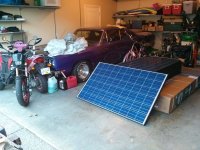I figure both of y'all know how heat makes cold. A Propane refrigerator, uses a pilot light to heat the ammonia and carry the heat out of the box into the condenser to release the heat. RV fridges use that along with 12V AND AC household electrickery.
For something like an A/C unit, you have to pump a lot of fluid-gas out of the container (House-whatever) to release the heat outside. You are talking , roughly, an Organic Rankin Cycle unit. There is a 10 page thread, over on a Biofuel Forum. I can copy-paste a link if y'all are REALLY interested. It's NOT a working unit, yet, but, some really into it guys are sharing ideas and getting close.
Jay has working Swamp Coolers, so, just imagine scaling up. Problem is, I believe they need a recharge of evaporating water, to function?? If you have even a small stream running near the house, running the heat exchanger coils under water will cool off the returning gas to the house, just like an A/C unit. A small pump would be cheap to run, compared to a compressor.
EDIT: Jay posted while I was making up my post.
In our Arkansas Earth-sheltered house, when I dug the in-ground part out, and layed up the block walls, I put 3-4" Plastic pipes on the bottom outside, on top of some small rock, gravel, no sand. That was for carrying cool, ground cooled air into the house. On the block walls, I smeared roofing tar, 5 gallon pails of the stuff, mashed 2 layers of folded 4 mil plastic sheet into the tar, put 2 layers of 1" underlayment styrofoam sheets, then used roll-roofing, to protect from punching holes through everything. Then, the kids took the front loader tractor along the road, and scraped loose rocks into the bucket and slowly dumped that on top of the pipes, and made a waterway for rain to drain away, to keep the walls dry, inside the house. Under those 3 pipes, was another 4" slotted wall pipe, running around the 3 sides earth sheltered, that carried the rain water away. Kept the air cooling pipes from having water in them.
On hot days, the cool air entered the house, and allowed the hot air to escape out the Solar Chimney I built. It worked even better, when I hunk a 20" box fan inside the solar chimney, pointing up, to help push the hot air up and out of the house.
We had a Servel fridge, that even made ice cubes in the freezer part.
IF y'all had the option, a galvanized or Aluminum 12" or larger sized culvert pipe system buried in a closed loop around the yard, and fed into the house and ducted back into the loop, would keep the inside temps at tolerable levels. Need a backhoe to do the loop, and back fill the ditch, but, no need to power anything other than a furnace squirrel cage type blower to move the air into-out of the loop. Ground temps in most areas will run 56°F at 8' of depth, year round. That cool tube will also provide the warmer air in the winter. Of course, fudge factors exist with each individual system.
Just taking the moisture out of the air, will make the house feel much cooler.
I built "Breadbox" water heaters, also, along with Window boxes. Bread boxes are larger boxes, insulated, and water heater tanks placed inside, painted flat black, and plumbed into the existing hot water lines in the house. A temp sensor and how water furnace pump moved the water into and out of the heater.
The window boxes were made with "Duct Board", the fibreglass board with aluminum foil on one side. It was a leaning type set up, where you cut the board so it would fold up into a size to fit in a window. Tape up the seams, foil side out, and then, cut a panel out of the top sloped side, to "glue" a sheet of glass or even plexi, onto the outside.
On the inside, before taping up the sloping box, fasten a couple pieces of wood to the sides, about halfway into the thickness of the box, say 12" thick box, make the strips 6" down under the glass. Lay a piece of sheet metal, painted black on the upper side, onto the wood strips. Cut a half circle the width of the metal, out of the lower end, so air can circulate. Make the upper section of the box, so it fits snugly into the window opening, so you shut the window down onto the box, to seal it up, sort of. Stuff some foam into any cracks.
The box will be open inside the house, so the hot air from the box will escape and rise, while the cooler air will go into the box, and fall to the bottom, where it will get heated as it travels back up on the upper side, back into the house.
Of course, this all depends on how the house is positioned on the lot, referencing to the sun passing overhead.





